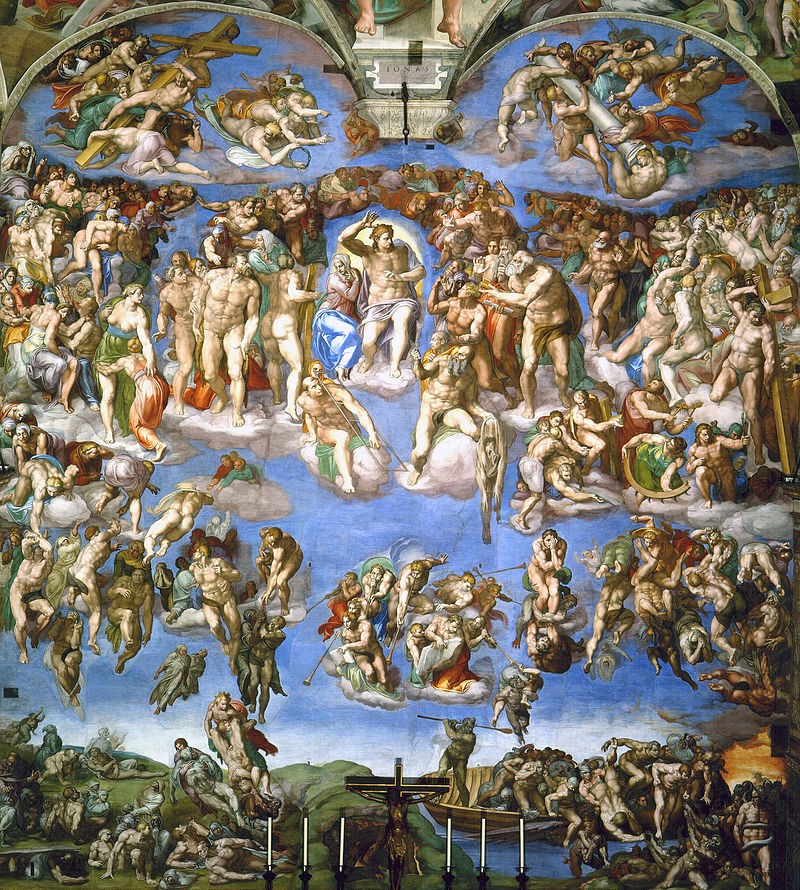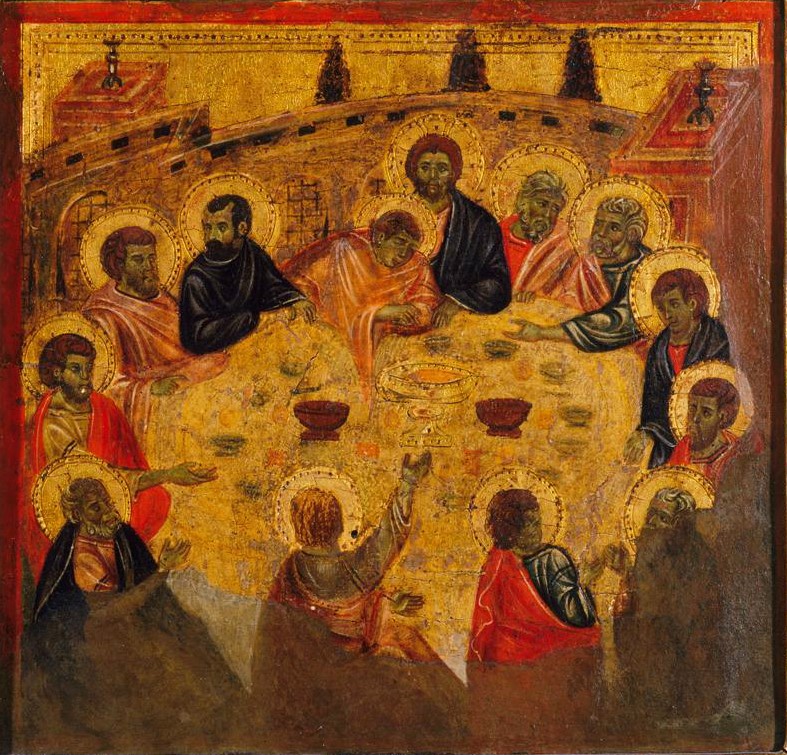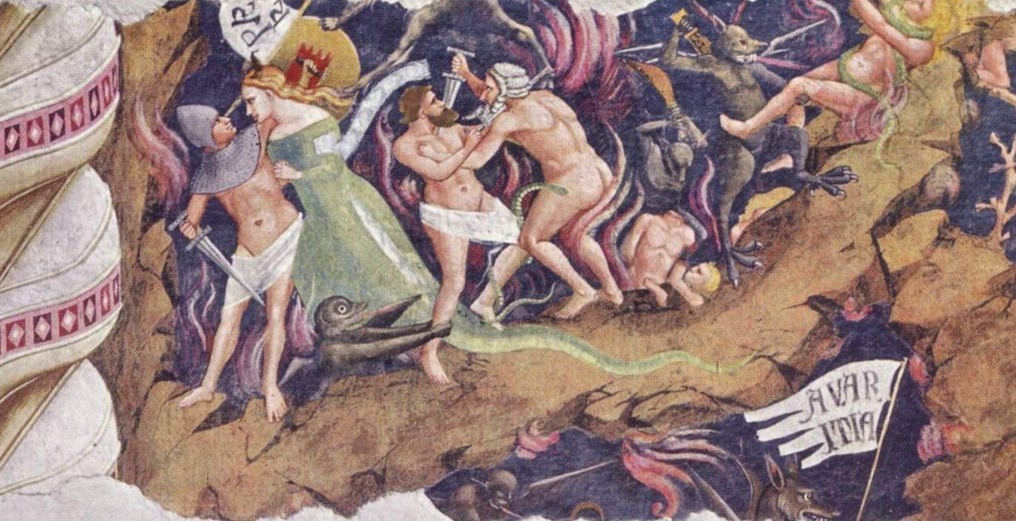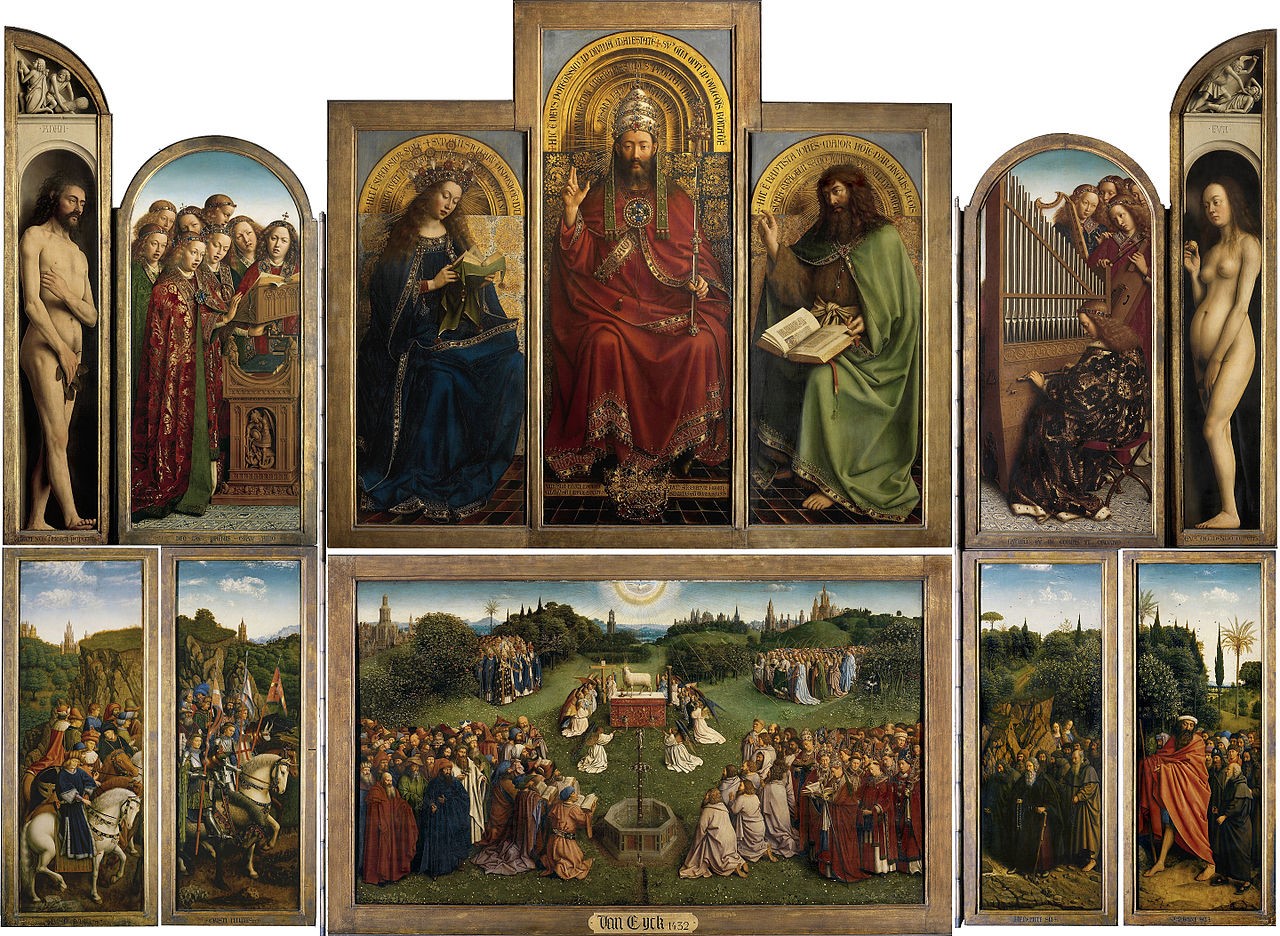Being a medieval historian means quite a few things. Among other things, it means you get irrationally irked by the popular usage of medieval as a pejorative, make literally no money at all ever (Haha – I’m not joking, tho. HELP.), and spend a lot of time being frustrated with the concept of the Renaissance. Over this time, I have come to realise that the Renaissance is, in many ways, like the seminal classic Hey Ya by Outkast.
Now the thing about the Renaissance is that, much like Hey Ya, everyone can agree it is cool as hell. We’re out here enjoying that art and damn if it is not amazing.
I mean, witness Titian: (The Sacred and Profane Love, c. 1513-1514)
(The Sacred and Profane Love, c. 1513-1514)
Or Botticelli: (The Birth of Venus, c. 1485)
(The Birth of Venus, c. 1485)
Or, of course and always, Michelangelo: (The Last Judgement c. 1534-41)
(The Last Judgement c. 1534-41)
These are all very fine paintings, and I think we can all agree, that they are amazing.
Much like how Hey Ya is a transcendental meditation on heartbreak that somehow forces even baby boomers to dance.
Now I am not here to argue that Renaissance artwork, or philosophy, is not good. Much like attempting to argue that Hey Ya is not a total and complete banger, that would be a fool’s errand. What I am here to argue is that the common understanding of the Renaissance, much like that of Hey Ya, is incorrect and does a massive disservice to the art and philosophy of what came before it, and the art and philosophy happening in tandem with it that cannot be classified as a part of it. (Yes I am also talking about Outkast’s back catalogue and the Love Below in addition to the medieval period.)
Now, backing right the fuck up, it’s important to note that much like Hey Ya, the concept of the Renaissance is, all things considered, fairly new. It did not even exist in the eighteenth century, and though you do see it crop up in the nineteenth, it existed in a totally different way to the concept we hold now.
Why is this? Well the concept of the Renaissance hinges on the idea that there is a cogent cultural movement happening at a particular time that we can point to. When the average person hears the term Renaissance they might be thinking about paintings, or architecture, or maybe even the wealth accumulation of the Medici family. That is all well and good, but in the eighteenth century people would point out, pretty correctly, that everything you just thought about happened pretty much in isolation of each other. It took coming up with a whole new concept of history to make that happen. The TL/DR of this historiographical shift is that in order for the Renaissance to be a thing, you have to stop looking at history as only a chain of events happening in a progression, and start thinking about whole blocks of activities happening as a coherent whole over space and time. Also you need to, like, get some more sources to look at.
The source that most mofos who took this approach pointed to was a certain Giorgio Vasari. Vasari sorta kinda invented the discipline of Art History when he wrote The Lives of the Most Eminent Painters, Sculptors, and Architects. It was essentially a who’s who of dudes making art in sixteenth century Italy. He’s the first guy who used the term ‘La Renaissance’ in print. So fine, but you need to understand that homeboy was also a painter, architect, etc etc, and very very much invested in convincing his patron Cosimo I de’ Medici that the art and architecture going on right then was defo the best thing that had ever happened and that anyone who spent money on it (hint, hint) was, like, really tasteful and forward thinking and great. It is not an unbiased account of the art that was happening.
Though Vasari was the first to write ‘Renaissance’ he was building on the concept of Leon Battista ‘Hater Patrol’ Alberti, who was yet another author, artist, priest, who-even-fucking-knows-rich-dudes-had-a-lot-of-time-and-money-on-their-hands-back-then, who invented the term ‘Gothic’. But don’t worry he didn’t invent it to be like check this architecture out IT IS AMAZING:

No, he meant ‘Gothic’ as in ‘barbaric’, as in anything that Germanic people are doing is bad. Because I am not a German. And I think that anything that isn’t happening in the Italian speaking lands is moot. Because I want to be important real bad.
So anyway, these ideas were picked up by later historians who started transforming it into the concept of the Renaissance that you know. The first time we see ‘la Renaissance’ used in the way we mean it now is by one Jean Baptiste Seroux d’Agincourt. Homeboy was an archaeologist and historian who did a lot of travelling, got himself hooked up with a structural approach to history, and gave you the term.
Voltaire, who as you may know I am fighting with, then took this idea and ran with it. Mostly because he was a giant douche who thought he was a lot smarter than medieval people because he had the benefit of all their philosophical work and therefore thought he was smarter than them. Which he wasn’t. He sort of went through history cherry picking stuff he liked and declaring it reasonable because it appealed to him. The ‘reasonable’ things he chose to focus on were the Emperor Constantine, the thirteenth and fourteenth centuries in Italy, and then the sixteenth century. I don’t know, OK? I can’t explain this fucking guy.
Voltaire pretty much DGAF about visual art and spent most of his time cranking it over the Divine Comedy and the works of Petrarch, which are medieval, but something something Renaissance. And he was like, you know what – this Vasari guy? The one who wrote a whole book about how his work and the work of all his friends was TOTES the best ever in order to get more money? He was totally right and in no way using hyperbole. He was also definitely in no way a total exclusionary bastard determined to undermine any work not done by people in the Italian lands.
Voltaire’s approach here is, obviously, basic as hell, but also requires some really fucking weird mental gymnastics. See in order for all this to be true – that there is a Renaissance where art is reborn out of something that was Very Bad™, you also have to have things like the proto-Renaissance which happened in the thirteenth century and features amazing painters like Cimabue: (The Last Supper, late thirteenth century)
(The Last Supper, late thirteenth century)
Or Orcagna: (The Triumph of Death, c. 1350)
(The Triumph of Death, c. 1350)
Because in order for the Renaissance to be true – the idea that there was a time of Very Bad Art and Thought™ in the medieval period that Italians somehow pulled us out of – you have to explain away all of the really good art and thought that was happening in the medieval period and that anyone with a pair of eyes can go have a look at.
How do you do that? Oh – you just call anything you like ‘proto’ Renaissance. So suddenly you can keep Petrarch and Dante as Renaissance people, even though they were working staunchly in the medieval period. See how that works? Basically if you like a medieval thing, you just take it out of its context and say ‘Oh yeah, um, that’s good because it’s PROTO-RENAISSANCE. Not because the medieval period was a rich and diverse time that had a lot of achievement in art and thought and things were changing all the time and probably that had a lot of influence on early modern art.’
This approach is a whole hell of a lot like every motherfucker who never bothered to listen to any Outkast before or other than Hey Ya and was suddenly like, ‘Oh this is amazing!’ Now I am in no way here to discredit those who would declare Hey Ya the greatest pop song of this generation. What I take exception to is the people who love this song, and hell, maybe even The Love Below, but haven’t managed to acknowledge the song itself as an apotheosis made possible because of the decades of fucking hard ass work that Outkast put into making music.
The blind worship that the casual fan has for Hey Ya ignores the years that Outkast spent making the dankest possible music whilst simultaneously being ignored in a culture that reverently held up East and West Coast as the only possible styles of hip hop. It ends up treating the remarkable brilliance of their earlier work in the same way that historians who buy into the myth of the Renaissance treat medieval art.
Basics are out here like, ‘Oh B.O.B is certainly brilliant – the flows are SO AHEAD OF THEIR TIME.’ No motherfucker, Outkast were not ‘ahead of their time’. They were just brilliant enough at the fucking time to write that goddamn song. It was their fucking time and you weren’t ready for it.
I mean hell, Hey Ya is, in many ways, a totally logical follow up to the transcendent SpottieOttieDopaliscious. SpottieOttie is a master class in relating the pressures that surround romantic relationships and the real world struggles that impact and stress infatuation, much in the way that Hey Ya is, and it also comes at you with a smooth instrumental line that is absolutely legendary.
Like, do you even remember when Elevators dropped? This flow was coming at you in 1996. And on it, they straight up called us all out on the fact that they were here creating this art and we were ignoring them in order to pay attention to East Coast/West Coast nonsense. I am not saying California Love is not also very important, but ask yourself which flow is more intricate. I’m just saying.
Hey Ya didn’t come from nowhere, just like the Renaissance didn’t just spontaneously occur after a period of dire art.
Moreover, when talking about how brilliant either the Renaissance or Hey Ya is, both discussions also ask you to ignore the other art that was simultaneously being produced.
In order for the Renaissance to be true – i.e. the idea that a bunch of Italians ‘rediscovered’ classical art and that is why they suddenly made ‘good’ art – you need to completely ignore the art coming out of the low countries. See, up in the low countries at the same damn time you have absolute genius bastards like Jan van Eyke throwing it down. Witness his Ghent altarpiece, which I like to refer to as Space Lamb:
 (The Altarpiece of the Mystical Lamb, c. 1432)
(The Altarpiece of the Mystical Lamb, c. 1432)
There’s also Robert Campin:

(Right hand panel of the Werl Altarpiece, 1438)
Or how about Rogier van der Weyden? (The Descent from the Cross, c. 1435)
(The Descent from the Cross, c. 1435)
All these badasses were out here throwing down this fire ass art, and NONE of them were consciously emulating antique art. This style grew directly out of medieval art and features all of the same things that everyone wants to celebrate about the Italian Renaissance. It has the perspective, the human focus, the colour. Hell – THESE WORKS ACTUALLY INFLUENCED THE ITALIAN PAINTERS AT THE TIME, so don’t come at me with the idea that you have to have a bunch of Italians look at Roman art in order for art to continue to develop. That makes no fucking sense.
In the same way our constant worship of Hey Ya totally ignores the fact that Speaker Boxxx is a better album than the Love Below. Yes it was. I will cut you.
I mean come the fuck on, Ghetto Music??? Are you even joking???
You know you listen to Speakerboxx more often. If you don’t you have terrible taste.
Bow Tie is one of the greatest songs of all time.
I will fight you and I will win. Come at me.
In summary – the myth of the Renaissance is born out of the same old basic ignorance of the medieval period that we see day in and day out. Mix that in with an attempt at convincing some rich and self-important guys from the Italian lands that they are definitely the most special and best, and sell that on to some self-important guys in the eighteenth century who need you to know that they are smarter than everyone else and voila – the Renaissance.
Yeah the art is great – fuck – Hey Ya is great. The problem is when people believe that these things sprung fully formed from the head of Zeus, and were not a part of a process that had been happening for years and years. The artistic output of medieval people, much like the early work of Outkast, is what made these crowd-pleasers possible. But hell, Renaissance art wasn’t even necessarily the best art happening at the time. Some of it is absolutely stellar – much like Hey Ya – but a lot of the other stuff happening is only sort of so-so (like a lot of the Love Below) and pales in comparison to the work we see coming out of other places like the low countries (or Speakerboxx).
I’m not saying don’t enjoy any of this stuff. What I am saying is don’t be basic. Try to look at all of this work with a critical eye.
Now go listen to Stankonia.
If you enjoyed this, please consider contributing to my patreon. If not, that is chill too!
For more on art and art history, see:
Religious iconography has always been a prop
Look up, this church is judging you
For more hip hop history see:
These hoes ain’t loyal – on prostitutes and bad bitches in medieval and hip hop culture
On Hotline Bling and courtly love
Kanye West is the modern day Peter Abelard
Considering bad motherfuckers: Hildegard of Bingen and Janelle Monáe
For more on myths about the medieval period and ignorance, see:
Plague Police roundup, or, I am tired, and you people give me no peace
How to win friends and influence people in medieval Europe on History Hit
If you are going to talk about the Dark Ages, you had better be right
JFC, calm down about the medieval Church
On Medical Milestones, Being Racist, and Textbooks, Part I
On Medical Milestones, The Myth of Progress and Being Racist, Part II
On medieval healthcare and American barbarism
I assure you, medieval people bathed.
On colonialism, imperialism, and ignoring medieval history
“I wasn’t taught medieval history so it is not important” is not a real argument, but ok
There’s no such thing as the ‘Dark Ages’, but OK
On the Concept of the Renaissance and Outkast’s Hey Ya
On why the misuse of the word ‘medieval’ is a bad thing


I love this commentary and it actually explains a lot of “Renaissance” art for me. So in this comparison, where does something like “Ms Jackson” fit? A song that paves the way for the celebration of “Hey Ya” but, IMO, sits awkwardly within Stankonia.
LikeLike
This is an important question, and I am happy to report to you that the answer is Ms Jackson is like Giotto. A precursor of things to come and often removed from its initial context by people attempting to create a narrative about the Renaissance. Giotto gets called a part of the Renaissance even though he works in the fourteenth century, but it fulfills the Renaissance criteria, so it must be Renaissance. Similarly Ms Jackson is singled out for attention by people who want Outkast to be makers of pop-like ballads.
LikeLike
I shall now go and listen to Outkast!! Seems like I’ve been missing A LOT 🙈
LikeLike
You have, and also I am excited for you.
LikeLike
Which is the same saying “hell, industrial revolution is way overrated, british propaganda just ignore other people inventions happening elsewhere “
LikeLike